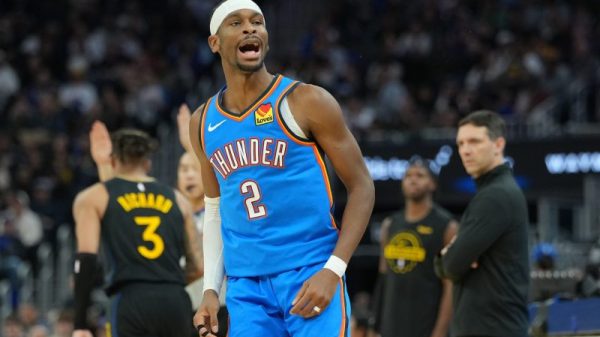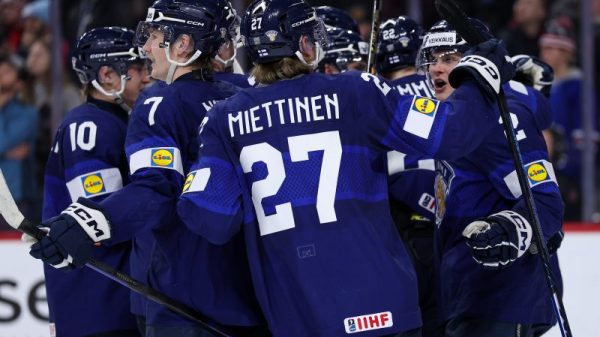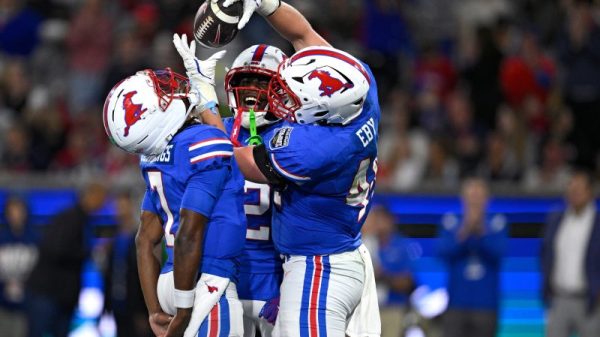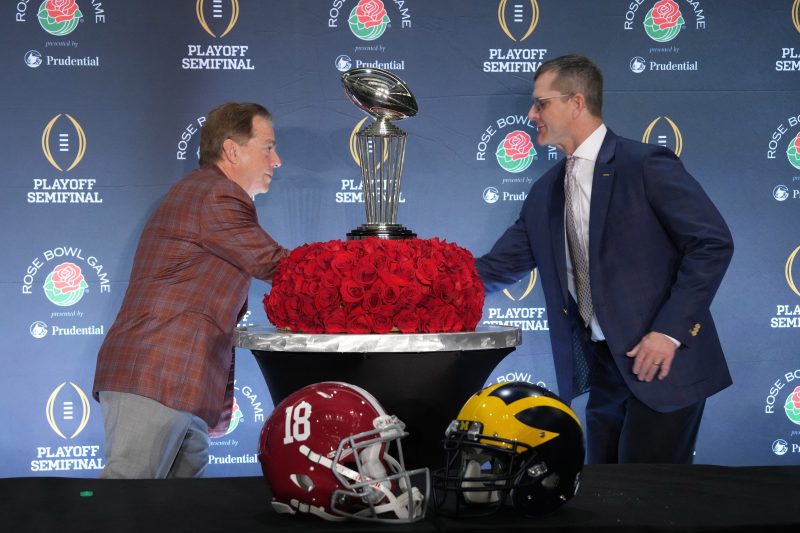LOS ANGELES — Jim Harbaugh had that familiar glazed-over look on his face that he often gets when processing a question he doesn’t want to engage.
‘Big picture? Day before the game? State of the union? Can we address some of those things after the game?’ he said.
‘I think it’s a great question,’ he said. ‘It would be a really, really good discussion to have at some point in time. I don’t think sitting up here today is the right time to do it.’
They had been asked about what college football is going to look like in the next few years, where it’s going – which isn’t merely a relevant question these days, it’s the question consuming the sport.
Just look around. There was Georgia coach Kirby Smart at the Orange Bowl on Saturday night demanding that, ‘People need to see what happened tonight and they need to fix this!’ after his team embarrassed Florida State’s decimated roster 63-3.
There was Penn State’s James Franklin, a man working on a 10-year, $70 million contract, calling this ‘one of the most challenging times in college athletics and specifically football,’ right before the Peach Bowl.
And finally there was Iowa’s Kirk Ferentz bringing the dark clouds to sunny Orlando prior to the Citrus Bowl, saying, ‘We, the adults, have done a lot to really screw this thing up.’
Really gets you pumped up to watch some New Year’s Day football, doesn’t it?
So it’s a welcome respite from all the doomsaying these days that Harbaugh and Saban chose to delay their airing of grievances and keep focus on the Rose Bowl and what should be an all-time College Football Playoff. Because what’s going to happen Monday really should be great, maybe historically great.
And when this dream set of semifinals ends – Michigan vs. Alabama, Texas vs. Washington – the sport is never going to be the same. It will change for the better, and also for the worse. Either way, if you think college football has gotten hard to recognize over the last decade or so, here’s a hard and important truth: You ain’t seen nothin’ yet.
‘Things are changing rapidly,’ Saban said this week. ‘I mean, they’re changing in business. AI is changing things. If you look at the changes in college football in the last three to five years, it’s probably changed more than it did in the 50 years prior to that.’
So buckle up, but also soak in and appreciate what’s about to happen as the four-team playoff era comes to an end.
After a decade full of bad matchups and games that did not deliver either the television ratings or the cultural impact they were supposed to, the CFP is finally going to look as it was intended. In fact, had we been given more of this – a pair of games that seem dead-even on paper, with any of the four teams having a legit chance to win the national title – there may not have been such a thirst to blow up the entire sport.
Next season, Rutgers at Southern California will be a Big Ten game. Cal at SMU will be an ACC game. Oklahoma at Missouri will be an SEC game. The Pac-12 will no longer exist.
If someone had gone around the Rose Bowl parking lot on Jan. 7, 2010 – the morning of Alabama’s last appearance in the venerable old stadium – telling people this is what college football’s future would look like, they’d have immediately cut off that person’s access to alcoholic beverages. You’d have also needed to explain the following phrases that are now ubiquitous in the college football lexicon: Opt-out, transfer portal, NIL, collective and probably a few more.
But this is now what college football is about, and despite huge television ratings this season, massive amounts of money flowing through the system and full stadiums from coast to coast, it doesn’t seem like anyone involved in the sport is real happy with the way it turned out.
‘Somebody has to grab ahold of the reins and take it in the right direction,’ Tennessee coach Josh Heupel said.
A couple days after the CFP championship game in Houston on Jan. 8, many of the sport’s power brokers will migrate directly to Phoenix for the annual NCAA convention. They undoubtedly have a lot to discuss.
Much of the focus there will be on a proposal from relatively new NCAA president Charlie Baker that sent shockwaves through college sports when he unveiled it in December. It calls for the creation of a new division that would require schools at the top level to put a minimum of $30,000 per year into a trust fund for at least half of its scholarship athletes. There’s a long way to go before anything would be adopted, but it’s a starting point for a model where colleges will be able to directly pay players, officially ending the NCAA’s long-held devotion to amateurism.
And it was telling that the first reaction of so many veteran administrators, including SEC commissioner Greg Sankey, was to complain that the conference commissioners weren’t kept in the loop.
Baker, the former governor of Massachusetts, is a smart politician. He’s trying to make a deal with Congress to get a law passed that would include favorable antitrust protections for the NCAA, and he knows it’s going to require some concessions to benefit athletes.
There’s a long way to go before any proposal gets passed, but he’s taking a first step toward solutions that are long overdue – and not waiting for a series of NCAA subcommittees to spend months debating general concepts before everyone loses interest in passing something meaningful and kicks the can down the road for another couple years.
That’s the NCAA culture Sankey and his colleagues come from: debate, delay and ultimately do nothing. Then changes such as NIL, unfettered transfers and ridiculous conference alignments get forced on them while they’re flat-footed with no ability to regulate their own sport. Is it any wonder college football looks like such a mess?
Now, there are no easy answers. The hole is deep, and it’s going to take significant trade-offs to climb out of it. But college sports doesn’t do very well with trade-offs. It’s time to accept that choices will need to be made, that you have to give something to get something.
There may never be a perfect system, but unless you start with the goal of creating a win-win for everyone – including a recognition that players are indispensable cogs in the multibillion dollar business they’ve created – it will continue to be an ungovernable disaster.
But as Harbaugh and Saban said, that’s a topic for another day. In fact, it’s going to be the only story that matters for the next couple hundred days before the 2024 season kicks off.
So let’s put the angst aside and enjoy this one, last uncomplicated day of a sport that at its best can deliver simplicity, pageantry and beauty. The politics around college football will probably get worse before they get better, but Monday’s semifinals hold the promise of why this sport is worth preserving in the first place.



























